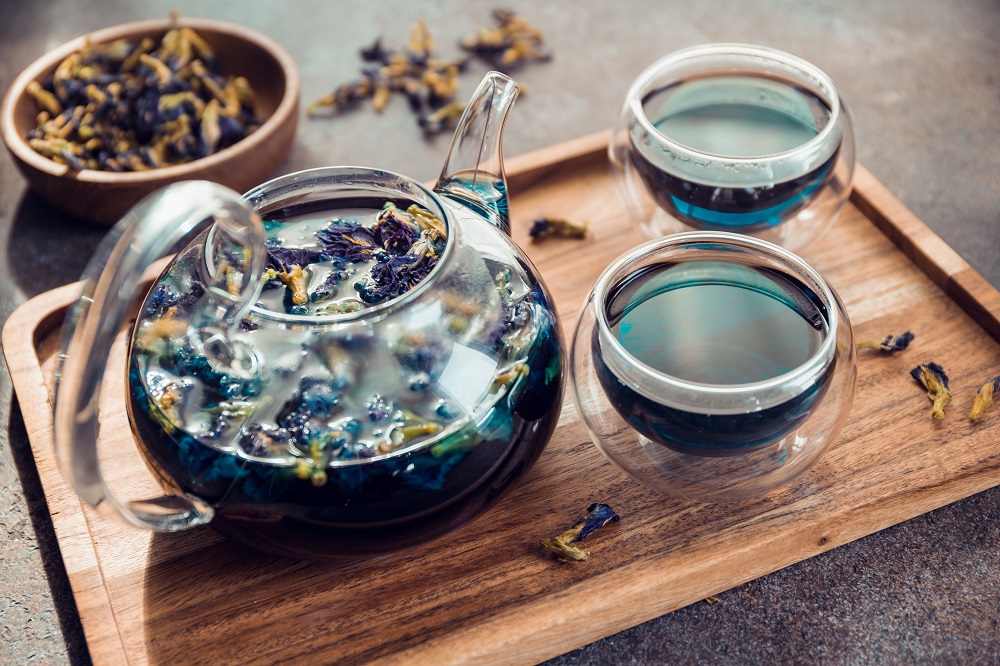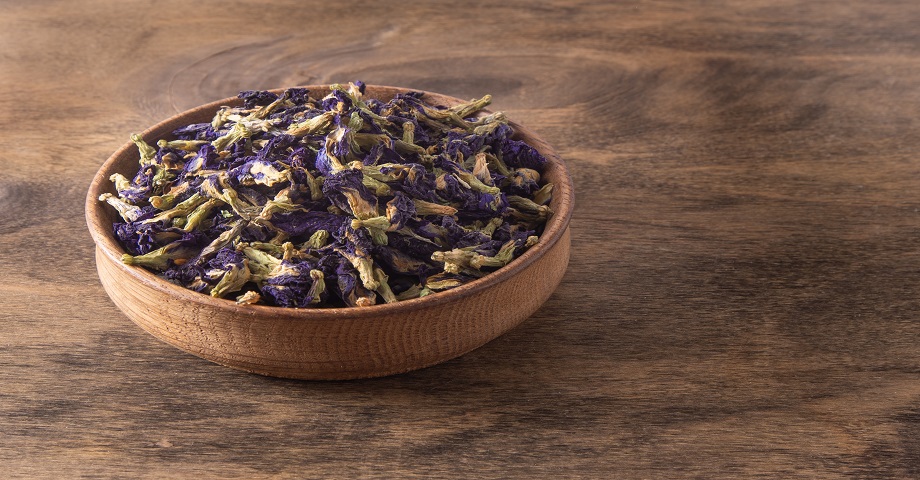Butterfly Pea Tea - properties and effects of blue tea

Butterfly pea tea is a colorful brew that catches the eye and tempts with an aromatic scent. Due to the possible health-promoting effects, the Clitoria ternatea encourages not only enthusiasts of colorful and photogenic liquids.
Butterfly pea is a tropical plant, grown both for their nice appearance and for their valuable properties. In traditional Ayurvedic medicine, it has been known and used for centuries. It is recognized that the plant can have, among others, relaxing, anti-inflammatory and analgesic effects. What other properties can have blue tea? Is the infusion of flowers of the Clitoria ternatea worth including in the daily diet?
What is butterfly pea tea?
Butterfly pea tea (Clitoria ternatea L.) or butterfly pea, Asian pigeonwings or Darwin pea, is a climbing tropical plant of the Fabaceae family, with alternating leaves, whose flowers, about 4 cm in size, most often take a blue-purple coloration and are reversed by 180 degrees relative to the flowers of other butterfly plants. Butterfly pea tea fruits are 5-12 cm pods, which contain from 5 to 10 seeds.
The name of the plant is associated with its flowers, which look like female reproductive organs. In addition, the creeper, due to the color of the infusion, is also called blue tea. However, it is worth noting that "blue tea" is a name used conventionally. In fact, the plant has nothing to do with traditional tea, obtained from the leaves of the Camellia sinensis plant. Butterfly pea tea is an infusion made from dried flowers of the Clitoria ternatea.
The African continent is considered to be the natural habitat of the Clitoria ternatea, but the plant quickly spread around the world. In some countries with a tropical climate, it is treated as an ornamental plant, due to its nice appearance. In Asian countries, it is often used as a food dye. Sometimes the Ternatian clitoris is also used as a fertilizer, but most often the plant is used in herbal medicine - it is a vine with pro-health properties, well known in traditional Ayurvedic medicine. In Europe, hand-picked flowers are used to make blue tea. What distinguishes this drink and when is it worth consuming?
Active ingredients present in Clitoria ternatea
Blue tea is a wealth of active ingredients. In the Darwin pea can be distinguished compounds such as anthocyanins to which the plant owes its blue color, as well as flavonoids, lactones, phytosterols or terpenoids.
In addition, butterfly pea tea contains powerful antioxidants, such as p-coumaric acid or kaemferol, and delphinidin-3,5-glucoside. The plant also contains compounds such as vitamin A, dietary fiber and fatty acids.
In the roots and leaves of the Clitoria ternatea, can also be found triterpenoids, flavonoid glycosides and alkaloids.

Properties of butterfly pea tea
In traditional Ayurvedic medicine butterfly pea tea was used for its analgesic, anti-inflammatory and relaxing properties. In addition, the Clitoria ternatea was used to improve brain function and as a diuretic. It was also used as an antidote for snake and scorpion bites. What do we know about blue tea today? What properties of butterfly pea tea have been scientifically confirmed?
Because Darwin pea is rich in antioxidants, the plant can fight free radicals in the human body and eliminate reactive oxygen species. At the same time, butterfly pea tea can reduce oxidative stress and delay aging processes.
In addition, blue tea can reduce the risk of developing diabetes - regular drinking of the infusion from the plant can increase the level of antioxidants in the body, and at the same time contribute to lowering blood glucose levels. Moreover, the Clitoria ternatea can act antihyperglycemic and improve insulin secretion and prevent excessive absorption of sugars from food. The plant can also protect cells from damage and complications associated with diabetes.
Regular consumption of butterfly pea tea can also have a beneficial effect on the cardiovascular system. The active compounds present in the infusion may be responsible for regulating capillaries and sealing blood vessels, and may also strengthen the circulatory system. The Clitoria ternatea extract can improve vascular function and have antihypertensive effect. At the same time, the plant may contribute to the reduction of total cholesterol and its LDL fraction and an increase in the concentration of HDL fraction in the blood serum. Due to the presence of bioactive anthocyanins in blue tea, the infusion may have a hypolipidemic effect.
Butterfly pea tea can also support digestion and removal of toxins from the body and support the proper functioning of the digestive system. The plant can also have anti-inflammatory effects, inhibiting the activity of enzymes responsible for the occurrence of inflammation in the body. In addition, aqueous extract of the Clitoria ternatea may reduce the level of leptin in plasma and free fatty acids and may reduce postprandial lipemia. Preliminary research suggests that substances present in butterfly pea tea may block the synthesis of fat cells and promote weight reduction, however, further research is needed to confirm the beneficial effect of the plant on weight loss.
The Clitoria ternatea may have a calming and relaxing effect. It can relieve tension and stress and improve mood. Butterfly pea tea can increase energy levels in the body and improve concentration. In addition, the plant can positively affect the condition of the skin, hair and nails. The drink can reduce the appearance of wrinkles and contribute to lightening the skin. It can also promote the reduction of discoloration. In addition, blue tea can support hair growth and strengthen hair follicles and nail plate.
How to brew blue tea?
To be able to use the beneficial properties of butterfly pea tea, it should be properly prepared. How to brew the Darwin pea?
Dried plants (4-6 flowers) should be poured with very hot water, with a temperature of 90-100 degrees Celsius. Then the cup should be covered and set aside for about 7 minutes to brew. It is important that blue tea should not be brewed again - one portion of dried tea is enough to prepare one cup of infusion.
Butterfly pea tea without additives is characterized by herbal, slightly earthy and woody aroma. Because the plant is sensitive to pH changes, when lemon is added to the drink, the tea may tint to purple.

Clitoria ternatea - purpose
Although in Europe butterfly pea tea is most often used to prepare blue tea, the Clitoria ternatea is distinguished by its wide purpose.
The plant is used as a food coloring and also as an ingredient in many dishes. In Malaysia, the plant extract is used to make sticky rice, known as kerab. In Burma, the flowers of the Darwin pea are wrapped in dough and fried. Butterfly pea tea is also used to make syrups and alcohol popular in Australia, which is Ink Gin.
Side effects and contraindications to the use of Clitoria ternatea
Butterfly pea tea is a drink that can be an interesting alternative to traditional tea. Scientific research on the possible health-promoting properties of the plant and the side effects resulting from its use is still ongoing. So far, it has not been found that the consumption of Darwin pea is dangerous. However, it has been observed that taking blue tea in excessive amounts may contribute to the occurrence of nausea and diarrhea. Therefore, it is worth maintaining moderation, including in the daily diet infusion from the Clitoria ternatea.

